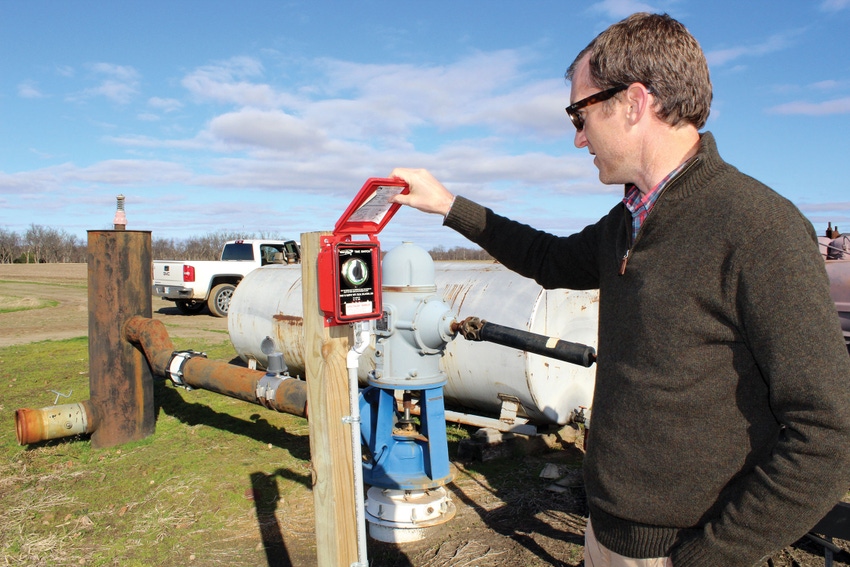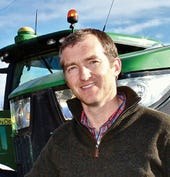
Patrick Johnson Jr. - ag environmental advocate
Patrick Johnson Jr., Tunica County, Miss., farmer and partner in Cypress Brake Planting Company, is Delta F.A.R.M.’s seventh and current chairman. “Our organization has one priority, which is clearly reflected in our policy — to promote agricultural conservation while maintaining farm profitability.”

Having the foresight to recognize a need, and then gather the critical mass support to eventually create something that benefits many, are attributes of true vision and leadership.
Billy Percy and a group of farm operators and landowners in the 13,355 square mile Yazoo River Basin of the Mississippi Delta, all brought these attributes to the table when they gathered together in the late 1990s to discuss the growing issue of conservation and environmental concerns surrounding production agriculture.
“By the summer of 1998, the group had mapped out a pilot program to ground proof their theory of the program’s viability,” explains Trey Cooke, executive director of Delta F.A.R.M. (Farmers Advocating Resource Management).

Photos: Patrick Johnson Jr.
After enrolling 161,000 acres of Yazoo Basin farmland into the program (far more than they initially anticipated enrolling), grower endorsement for the program was confirmed. Various agricultural interests stepped up and tendered seed money support, and by October 1998, Delta F.A.R.M. was formally established and Percy’s vision became reality.
Patrick Johnson Jr., Tunica County, Miss., farmer and partner in Cypress Brake Planting Company, is Delta F.A.R.M.’s seventh and current chairman. “Our organization has one priority, which is clearly reflected in our policy — to promote agricultural conservation while maintaining farm profitability,” says Johnson.
While that priority sounds singular in scope and simple enough, the impact and influence of Delta F.A.R.M. is as far-reaching across the Yazoo Basin as the winding system of rivers that flow through it — starting with the Coldwater River in the northern area, and ending with the Yazoo River before it empties into the mighty Mississippi, just north of Vicksburg, Miss.
While the organization leans on private, state and federal agencies for technical input, Delta F.A.R.M. is a farmer organization, run by farmers, for farmers. The 13-director farmer/landowner board directs program activities through a staff of five, whose offices are located in Leland.
“We rely on technical assistance from private companies and several governmental agencies like USDA and the Mississippi Department of Environmental Quality, to develop Best Management Practices and projects that will have a positive impact on the ground level,” says Johnson.
From organizations like the Mississippi Farm Bureau and the U.S. Army Corps of Engineers, to the U.S. Fish and Wildlife Service and Delta Wildlife, some 20 partnering organizations lend their experience, expertise and influence to the overriding agricultural conservation goals of Delta F.A.R.M.
Major projects
The value and impact Delta F.A.R.M. brings to the table is easily seen in the environmental and conservation projects it spearheads. From projects to improve the conservation of individual farming operations, to large-scale programs designed to improve large tracts of land, or even bodies of water that collectively provide resources to farms and communities, program-based improvements are varied and multi-faceted.
“Our Bee Lake Watershed Implementation Plan is a perfect example of how our efforts improved not only an important water source for recreation and farming irrigation, but for the entire ecosystem surrounding the lake on which many natural and wildlife resources rely,” says Cooke.
The 11,870-acre oxbow lake was literally being filled in from multiple point agricultural sedimentary runoff, while aggressively growing alligator weed was threatening oxygen levels and recreational access to the lake.
“It would be a guess to say exactly how much topsoil my farm was losing to the lake annually, but scouring sheet erosion was visibly noticeable. After a water monitoring system was installed, we’ve been able to track not only the quality of our water runoff from my farm, but the subsequent levels of sediment loss in that water — which are today significantly lower,” says Holmes County’s Bryan Jones, who owns and farms Bonanza Plantation, which is located in close proximity to Bee Lake.
Through these environmental and conservation improvements, and many others that were put in place throughout the Bee Lake area, the lake itself as well as the surrounding community has seen a strong resurgence of business and recreational activities.
“By 2002, over 7 miles of buffers had been planted around the lake to prevent erosion, and the lake’s weir (a barrier obstruction that pools water and promotes control of water flow) was partially improved until funding was later secured for its complete reconstruction,” says Cooke.
Farms
Johnson’s farm has been in the program for 10 years and there are nearly a million acres currently enrolled in the program across the entire Yazoo Basin.
“When producers hear about the goals of the organization, and see the potential benefits, they are usually eager to enroll their farm in the program,” says Johnson.
Last year, Johnson’s operation was one of five farms selected to have Operation Pollinator habitat plots established on some of his marginal or less productive farmland (See Mississippi pollinator protection project first on commercial farmland…). Along with partnering organization Syngenta, Delta F.A.R.M. will this year evaluate the effectiveness of those nesting sites and the success they have had toward increasing populations of native bees.
At the same time, the two organizations work together to educate and advise all program participants on sustainable agricultural practices.
“All farmers recognize how important bee populations are to crops and Syngenta has been very proactive in getting these first few pollinator sites established,” says Johnson.
On the soil conservation side, slotted board risers have been installed at several field locations on Johnson’s operation to allow sediment to drop out of suspension before water flows off the farm.
“We then take that captured dirt and spread it over the turn rows around our farm, which helps to limit soil erosion,” says Johnson.
To increase efficiency of water use, a metering program now controls the timing of Johnson’s surface irrigation, which also frees him from having to travel out to each field to manually cut the pumps on and off.
“On some of our fields this fall, we planted a cover crop of tillage radishes and crimson clover to promote soil health,” says Johnson.
The root system of tillage radishes can reach 18 inches in depth and mine, or pull up, nutrients which can then be absorbed by the roots of major row crops. Crimson clover, a legume, blooms early and contributes nitrogen to the soil.
Being part of Delta F.A.R.M.
The cohesiveness of the organization is seen in its members, who collectively own or manage nearly 50 percent of the land in the Delta region. Becoming part of the program requires an annual assessment of each member’s farm. That assessment can now even be completed online.
“The annual evaluation is simply a questionnaire that delves into non-regulatory conservation information, but we strongly encourage each member to improve their farm’s conservation and environmental stewardship by implementing the Best Management Practices that we advocate,” says Cooke.
Cooke and his staff play an important supporting role to its membership when regulators visit the basin region. Delta F.A.R.M. keeps records of specific information related to what conservation practices and environmental improvements have actually been implemented on member farms.
“That’s a service they provide that can save a farmer a lot of headaches,” says Johnson.
Irrigation and water conservation are currently the two fastest growing aspects of the program. Information on these and many other topics can be found in their program manual, which may be accessed under the “Programs and Services” tab of their Web site www.deltafarm.org. An enrollment form to join Delta F.A.R.M. is available on the website.
About the Author(s)
You May Also Like



